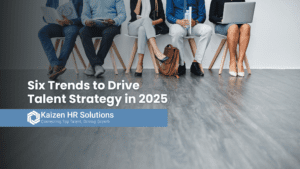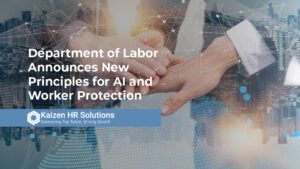At Kaizen HR, we always keep our finger on the pulse of top HR trends and shifts to give our clients the best and most timely advice possible. Saratoga, a workforce analytics and HR benchmarking product from PwC, recently released its “Top 4 Workforce Trends” based on its 2023 survey results. Let’s take a closer look at their statistics and the top trends of 2023 – and what they mean for your organization.
Turnover Management
Whether you call it the “Great Resignation” or the “Great Reshuffle,” one of the most apparent trends in the last couple of years has been a spike in voluntary turnover rates, as more employees left their jobs in search of better opportunities. Now, turnover is settling back down and headed towards pre-pandemic levels. This suggests both a stabilization in the job market and some successful strategies on the part of companies to re-engage employees.
Worth noting, however, is that the first-year turnover rate remains high, reaching 28% this year and indicating that there may still be some wrinkles to iron out in terms of ensuring a good fit and successful onboarding. Companies looking to lower this rapid turnover trend may want to look more closely at their initial recruiting and onboarding processes. In many cases, first-year turnover comes from a fundamental misalignment between an individual’s priorities and expectations with those of the company. Ensuring clarity and honesty during the recruiting process – and smoothing out the onboarding and training process – can go a long way towards retaining new hires beyond that first year.
The Pursuit of Quality Talent
As turnover slows, other talent management and acquisition areas are also affected. It follows that lower turnover rates correspond with lower external hire rates; the external recruitment rate dropped from 28.5% to 19.6% from 2021 to 2022. Internal mobility also seems to have slowed: the promotion rate decreased from 12.6% to 10.2%, and the mobility rate (encompassing both lateral and upward movements) dropped from 21.0% to 20.3%.
There’s also been a slowdown in the recruiting process: the average time to accept a job offer (measured from opening a requisition to accepting an offer) when hiring externally increased from 41 days to 54 days from 2021 to 2022. Companies operating on tight deadlines to fill critical roles will likely need to reconsider how to incentivize faster turnaround times, whether by updating recruiting processes, rethinking the employee value proposition, or other strategies. Candidates are taking a little more time to consider their options, and your company needs to figure out how to stand out during that decision-making.
Diversity, Equity, and Inclusion Efforts
Over the past few years, DEI has become increasingly central to hiring, retention, and overall reputation efforts. PwC’s research shows, however, that these efforts have not had equal results across diverse groups. For instance, the promotion rates among racial/ethnic minority women have improved, but the promotion rates for women as a whole, racial/ethnic minorities as a whole, Gen X, and Millennials have not. Retention, too, has varied widely. It’s another reminder that organizations dedicated to DEI work cannot use a one-size-fits-all approach but must consider and address varied groups’ dissimilar needs and challenges.
Similarly, the number of full-time professionals dedicated to DEI work has fluctuated and continues to vary across industries. The overall rate of DEI full-time equivalents (FTEs) has declined from 3.3% to 2.3% between 2021 and 2022. Building a genuinely equitable, inclusive workplace requires sustained, dedicated efforts, and companies with more extensive DEI functions tend to be more successful in implementing programs, initiatives, benchmarks, and more. As with most parts, you get out what you put in.
Strategies for Return to Office
Although hybrid and remote work have grown exponentially in the past few years, many companies and executives are now instituting a return-to-office policy. The result is a clear gap between what these leaders want and what their staff prefer. Forty-seven percent of CHROs expect in-office work four or five days a week, and 46% of leaders say they consider on-site presence when determining things like promotions and bonuses. Meanwhile, 62% of workers prefer a hybrid approach, compared with 11% who prefer in-person full-time.
Closing the gap between these preferences requires a more careful examination of what the work itself requires. For instance, 85% of hospital and health care workers are in-person full-time, while just 7% of financial services professionals are, reflecting the significant difference in the requirements of their roles. These factors can also affect employee engagement, satisfaction, and retention; companies looking to attract and retain top talent will need to get candid about what level of in-person work is necessary and what trade-offs may need to be made.
By Rose Dorta

Are you a high-performing leader or believe you have the potential to tackle a more challenging role? Would you be interested in career opportunities that are seeking these attributes?
I’d love to chat with you and answer any questions that you have. Email me, Rose Dorta, managing director of Kaizen HR Solutions, here.







